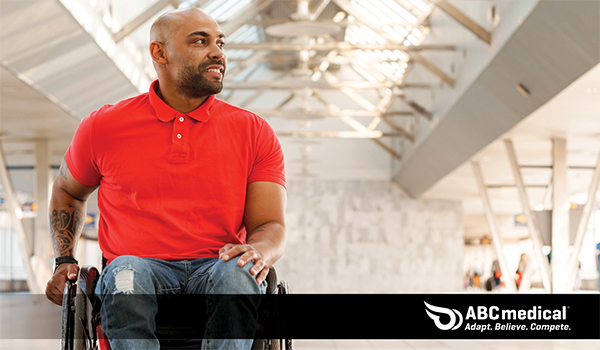
Traveling with a wheelchair can add stress to any trip, especially when traveling by air. As one of your trusted medical supply companies, ABC Medical is happy to help make such travel easier. Considering the following points can help make air travel a more enjoyable and smoother experience.
1 – Thoughtfully Plan Your Seating Assignment
Determine if you will need any specialized seating while on the airplane. Some rows, such as exit rows, are restricted to non-disabled passengers. You may want to ensure your seat is closer to the front, especially if you have limited walking ability. Airlines have aisle wheelchairs available to get you from the front of the plane to your seat, but it makes things a little more complicated. Some seats on the same airplane may cost more or may have upgrade fees after the ticket is purchased.
2 – Factor in Ample Time at the Airport
“Even if travelers aren’t checking luggage, arriving in advance of the departure time is very helpful for those with mobility issues,” says Alvaro Silberstein, a world traveler who is paralyzed from the waist down and founder of Wheel the World. In sync with most airline instructions, Silberstein suggests “arriving two to three hours in advance of an international flight and one and a half hours ahead of a domestic flight, just to give ample time for moving around the airport and making sure that requested accessibility assistance is in place.” This is even more crucial in light of our current labor market that continues to see labor shortages. This means that in some airports there could be fewer wheelchair attendants, which means you might have to wait for one.
3 – Wheelchair vs. Assistance
Determine if you need to bring your own wheelchair or if you prefer to request mobility assistance from airport staff. If you are an infrequent wheelchair user, you may find that having someone meet you when you arrive at the airport and bring you to the gate is the most convenient option. That might include being pushed in a wheelchair by an airline representative or riding an electric vehicle that takes you to the gate and meets you at your final destination gate. It is best to arrange this assistance when booking your flight or soon after to ensure availability.
3 – Manual vs. Electric
Determine if you will be bringing a manual or an electric chair. Remember to consider both your time at the airport as well as your mode of transportation when you arrive at your destination. Consider what you will need while at your destination.
4 – Cushion vs. No Cushion
Determine if you will need a cushion for pressure relief while on the airplane. Airline personnel can help you transfer your cushion from your wheelchair to your seat.
5 – Electric Battery
Some batteries may not be allowed on an airplane or may have to be stowed in a specific way. You may need to remove your battery or have someone help you remove the battery for safe stowing. Added devices like power assist may also require special care. For specifics for your flight, contact your airline’s special services.
6 – Before Checking Your Wheelchair
It is best to remove items such as footplates, cushions, wheel covers, drink holders, and any other parts that might break or come off during the flight. Your chair may shift during flight no matter how carefully it is loaded into the cargo hold.
8 – Remove All Valuables
Empty valuables, including your wallet, from your wheelchair bag or remove the bag entirely. Try to keep valuables either in checked baggage or on your person.
9 – Carry-on vs. Checked Baggage
Store prescription medications and supplies you will need soon after landing in your carry-on luggage to avoid problems if the airline loses the baggage that you checked. Baggage containing medical items such as catheters, enema supplies, and enteral feeding supplies may often be checked without paying an additional fee. This might require you to visit the airline counter (versus the kiosk) to take advantage of this benefit.
10 – Determine Unauthorized Items
Some items, like liquid glycerin, may be in your checked bags but are not legal to travel on your wheelchair or in the cabin. Therefore, contact your airline carrier for their current list of unauthorized items before traveling. Also, most airlines allow one free checked medical bag.
11 – Wheelchair Handoff
It is the goal of both you and the airline that you and your wheelchair arrive at your destination unharmed. Make sure you speak directly with the person that will load your wheelchair into baggage. You can ask at the gate to speak to that person. Show them how your wheels come on and off your chair, how the brakes work, and anything else specialized about your wheelchair. If there is anything broken on your wheelchair during the flight, ask at the gate for assistance to get you and the wheelchair to the location to report the issue. You generally have up to 24 hours to report a problem with the wheelchair, but it is easiest to do before you leave the airport. It is often helpful to know the name of the person with whom you spoke and handed off your wheelchair.
12 – Leverage TSA Cares if You Have Anxiety About Security Gates
Within 72-Hours of Your Flight
If you have questions about going through an airport Checkpoint with a wheelchair, take advantage of TSA Cares (855-787-2227), which is a helpline specifically tailored for individuals with disabilities, medical conditions or other special circumstances. Seventy-two hours before your flight, simply call TSA Cares and get your questions answered in advance.
At Least 72-Hours Before Your Flight
An additional feature provided by TSA Cares are Passenger Support Specialists – individuals who are specially trained TSA agents devoted to those with special needs. Upon request, a Passenger Support Specialist will personally accompany you through security. At least 72 hours before your flight, simply fill out an online form or make your request via the TSA Cares line, and a Passenger Support Specialist will then contact you to arrange a time and place to meet at the airport.
Disclaimer: This content is not intended to be a substitute for professional medical advice, diagnosis, or treatment. For medical advice, please speak with your healthcare provider.
References
https://www.aarp.org/travel/travel-tips/transportation/info-2022/flying-with-a-disability.html
https://www.tsa.gov/videos/tsa-cares-what-expect-when-traveling-mobility-aid-0



